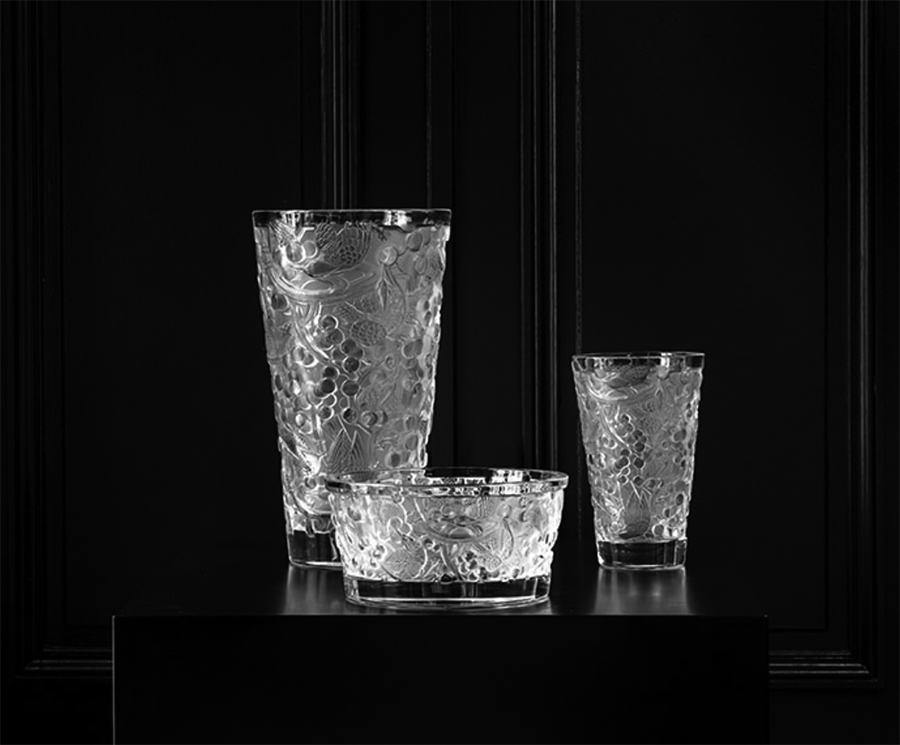How a childhood memory sparked half a century of collecting Lalique glassware.
Collections start in all sorts of ways and, in this article, a long-standing Aston Lark client tells Private Clients Director Julie Webb how his 300-piece Lalique collection evolved.
My grandmother’s glass vase of bright yellow daffodils was always a lovely childhood memory, so when she sadly went to live in a nursing home, I was asked to choose an item from her home as a keepsake. The vase was my wish.
I had not particularly known much about Lalique or appreciated its worth. Yellow is my favourite colour, so the vivid picture of the flowers in a vase was something special to me. The vase, called Ceylan, was probably a wedding present to my grandparents as they married in the 1920s. It is very much of its time, with a beautiful depth of colour and soft blue shading on the birds’ feathers. I am still particularly drawn to the crystal opalescent glass which gives a milky white effect.
A couple of years later, in the early 1980s, I bought a heavy Lalique bowl, Tournon, at an exhibition in Alexandra Palace, in London. We used it as a fruit bowl and our children could just about reach it on the kitchen worktop, grabbing an apple by letting the bowl lean towards them and allowing it to roll back. When we had our house contents revalued for insurance, and we discovered the bowl’s worth, we decided to put it on a display shelf and the fruit went into something more ordinary!
However, we do use our Lalique wine glasses and plates without panicking because we have accidental cover. My wife and I think, “What’s the point of having them if you can’t enjoy them?” The wine glasses tend to come out at New Year and special occasions.
We gradually began to discover more about the Frenchman René-Jules Lalique, who was probably the world’s premier glassmaker during the 1920s and 30s. He came to prominence at the International Exposition of Modern Industrial and Decorative Arts in Paris in 1925, creating the evocative Art Deco style we both admire.
We bought a piece of Lalique when each of our children were born and over the years we have purchased and sold items, both antique and modern. We have two decorative car bonnet mascots that were made between 1925 to 1931. In those days they would have had a base and wiring, so the mascot lit up when the car started moving.
I also got into buying modern Lalique perfume bottles. In 1907, Lalique and Francois Coty collaborated to create bottles for Coty’s perfume collection, so I was interested when, in 1992, I noticed René’s granddaughter had created ‘Lalique de Lalique’. The perfume was for sale in the duty-free shop in Heathrow, so I bought it on my way to Australia. A new limited-edition bottle comes out every year and since then I have bought my wife a bottle on her birthday. We put them on display and have kept all of the boxes.
Our Lalique collection now numbers around 300 pieces, but when it comes to investments, we did learn one important lesson from the Lalique shop manager in Gibraltar, where we found ourselves on holiday some time ago. She said, “Have a look around and buy something that makes you say ‘wow!’.” That was the best advice and we use that rule of thumb on pretty much everything we have subsequently bought.
I applied that rule when I caved in to buy ‘Suzanne’, named after Lalique’s daughter. We had got to know a reputable local dealer who specialised in Lalique and bought several items through him. I had lusted after Suzanne for many years so when he called to say one was for sale with excellent provenance, I spent more on it than I paid for our first London flat. The flowing gown is exquisite – Lalique’s trademarks are natural form and feminine beauty – there was a definite “Wow!”.
The client’s name has been withheld in the interest of security.
René-Jules Lalique: A master of glassmaking
Champagne-born René-Jules Lalique (6 April 1860 – 5 May 1945) was a jewellery apprentice and came to prominence in the mid-1880s. He honed his artistic skills at the École des Arts Decoratifs, École Bernard Palissy, in Paris and Sydenham Art College in London.
By 1905 he was a Parisian master and started manufacturing glassware alongside jewellery. His 1909 Lalique Glass exhibition in Paris put him in the spotlight, although five years later, during World War I, he manufactured practical items, including plain glass bottles and containers for hospitals and medicines.
After the war Lalique devoted himself to glassmaking and in 1922 founded the Verrerie d’Alsace glassworks at Wingen-sur-Moder in Alsace, a region with a long glassmaking tradition (this is now the world’s only Lalique factory and recognised as an Enterprise du Patrimoine Vivant, a living heritage enterprise).
During the next two decades Lalique created some of his most iconic glassware. By the late 1930s he had designed the chandeliers for the SS Normandie ocean liner, the interior decoration of the Côte d’Azur Pullman Express carriages and glass doors for Prince Yasuhiko Asaka’s residence in Tokyo.
Lalique’s son, Marc, took over the business when his father died in 1945. Marc’s daughter Marie-Claude became CEO in 1977, renewing the tradition of jewellery design and developing the fragrance business.
Swiss group Art & Fragrance acquired Lalique in 2008 to develop a global market and increase the production of crystal glassworks. Today the house operates across six areas – perfume, art, interior design, decorative items, jewellery and hospitality.
Lalique ‘a very stable market’
Simon Johnson, Department Director: Valuations, Trusts & Estates, at Bonhams auctioneers, says Lalique remains ‘a very stable market’.
He says, “Lalique continues to be popular among buyers – that’s private and trade. Collectors of Lalique are always excited by large single-owner collections and the auction houses are seeing high prices when pieces are fresh to the market.”
This opinion is shared by Frederick Fischer, Lalique Managing Director, UK, who confirms rare and good condition pieces continue to command the highest prices. He also offers advice on identifying the age of Lalique glassware.
He says: “Buyers can sometimes find there are telltale signs between modern and vintage Lalique, such as slight imperfections. If there are very small bubbles in the glass it is perhaps pre-1945, when Lalique moved from glass to crystal – imperfections are no longer tolerated.
“Another way to distinguish the period is by the signature. Until 1945, during René Lalique’s time, the pieces were signed ‘R. Lalique France’. From 1945-1960 the pieces were signed ‘Lalique France’. Since 1980, pieces are signed Lalique®France.
“Some sales come with exceptional stories, such as the family who found a Lalique vase in their attic in Morpeth, Northumberland. The vase, made in 1922, was one of only four ‘Deux Figures Femmes Aillee’ – featuring two winged female figures. It had a sale estimate of £30,000 but sold for £280,000.
“Interior decoration also achieves high prices and the Moineaux glass doors created for the dining room of Lady Trent realised £1.59 million at Sotheby’s Paris in 2011.”
Buying Lalique and insurance advice
- Buy from a reputable dealer or auction house to ensure authenticity.
- Keep all original packaging to gain maximum prices when selling.
- Avoid items with chips or cracks as they will not achieve top prices.
- Remember to ask your insurer to revalue your Lalique glassware about every three to five years to ensure your collection is valued at current prices.
It’s very important to protect your collection, just as you would a piece of art. Relying on a standard home insurance policy could leave you without essential cover or potentially underinsured.
To talk to us about the insurance you have in place, or to book an appointment for when your insurance is due to renew, call us on 020 8256 4901 or visit find out more about our collectibles insurance.
No hard sell, just good old-fashioned advice.
Originally published by Aston Lark and reprinted here with permission.








